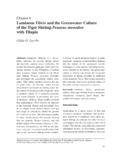Bacterial loads in hatcheries and virulence of Vibrio spp. to larvae of the tiger shrimp Penaeus monodon
- Global styles
- MLA
- Vancouver
- Elsevier - Harvard
- APA
- Help

ดู/
วันที่
2007ผู้เขียน
Page views
1,662ASFA keyword
AGROVOC keyword
Taxonomic term
เมตาดาต้า
แสดงระเบียนรายการเต็ม
Share
นามธรรม
Shrimp hatcheries are high-density systems and are prone to diseases. A small-scale and a large-scale hatchery for the tiger shrimp Penaeus monodon in Iloilo, Philippines were monitored over two months for water quality and shrimp survival. Water quality (water temperature, pH, salinity, dissolved oxygen, and specific gravity) was not significantly different between the two hatcheries. However, the small hatchery seemed to favor survival of eggs to early postlarval stages, whereas the large hatchery favored the survival of late postlarvae. The normal microflora and bacterial loads of tiger shrimp eggs, larvae, postlarvae, and rearing water were determined to identify the dominant bacteria and potential pathogens. Shrimp eggs harbored the lowest heterotrophic bacterial counts. The counts increased from the nauplii to the mysis stages, decreased during the mysis stage, and then gradually increased in the older larvae. Bacterial loads in the rearing water reflected those in raw sea water and reservoir-aged sea water. Vibrio, Pseudomonas, and Aeromonas were not detected in eggs but were found in postlarvae. Ubiquitous in sea water, these bacteria increased with the build-up of organic matter. The bacterial load in the water adversely affected larval survival. Forty bacterial strains were isolated from tiger shrimp eggs, larvae, postlarvae, from the feeds, and from the rearing water. These were tested for biochemical characteristics and segregated into eight groups or genera. Six genera were found in the mysis and five genera in the postlarvae. The Vibrio species were dominant. Only Escherichia spp. were present in feeds, whereas five genera were present in the rearing water. Only Vibrio and Pseudomonas were present in both larvae and water. Moraxella, Aeromonas, and Klebsiella were found in larvae but not in rearing water. Micrococcus and coryneforms were found only in rearing water. Four Vibrio isolates were tested for virulence against shrimp postlarvae at inoculation densities of 102 and 107 cfu/ml. The four Vibrio species caused mortality of postlarvae, and more at the higher inoculation density. The most virulent was Vibrio anguillarum—30% of postlarvae died after 24 h exposure to a bacterial density of 102 cfu/ml, and all larvae died after 48 h at 107 cfu/ml. Shrimp hatcheries must have protocols for hygiene and sanitation and for disease prevention and control.
การอ้างอิง
Torres, J. L. (2008). Bacterial loads in hatcheries and virulence of Vibrio spp. to larvae of the tiger shrimp Penaeus monodon. In T. U. Bagarinao (Ed.), Research Output of the Fisheries Sector Program (Vol. 2. Reports on Fisheries and Aquaculture, pp. 87-92). Quezon City, Philippines: Bureau of Agricultural Research, Department of Agriculture.
Type
Book chapterISBN
9718511776
Related items
Showing items related by title, author, creator and subject.
-
Studies on the efficacy of Sarafin® (sarafloxacin hydrochloride) on vibrios associated with vibriosis in black tiger shrimp (Penaeus monodon)
Pakingking, Rolando V., Jr. ; Lacierda, Erlinda; Torres, James L. (Fish Health Section, Asian Fisheries Society, 2002)
In vitro activity of Sarafin® (sarafloxacin hydrochloride) was determined against 7 luminous Vibrio harveyi isolates and 3 non-luminous Vibrio species (V. parahaemolyticus, V. alginolyticus and Vibrio species) isolated ...
; Lacierda, Erlinda; Torres, James L. (Fish Health Section, Asian Fisheries Society, 2002)
In vitro activity of Sarafin® (sarafloxacin hydrochloride) was determined against 7 luminous Vibrio harveyi isolates and 3 non-luminous Vibrio species (V. parahaemolyticus, V. alginolyticus and Vibrio species) isolated ... -
Luminous Vibrio and the greenwater culture of the tiger shrimp Penaeus monodon with tilapia
Lio-Po, Gilda D. (John Wiley & Sons, Ltd, 2017)Luminous vibriosis is a devastating infection of penaeid shrimp larvae and juveniles causing heavy mortalities. To counter the bacterial pathogen, Vibrio harveyi, shrimp farmers in the Philippines modified their growout ... -
Isolation of Vibrio spp. from Penaeus monodon (Fabricius) with red disease syndrome
From January 1990 to June 1993, 59% of the total juvenile to adult shrimp Penaeus monodon submitted for diagnosis at the Fish Health Section of the Aquaculture Department, Southeast Asian Fisheries Development Center, ...





